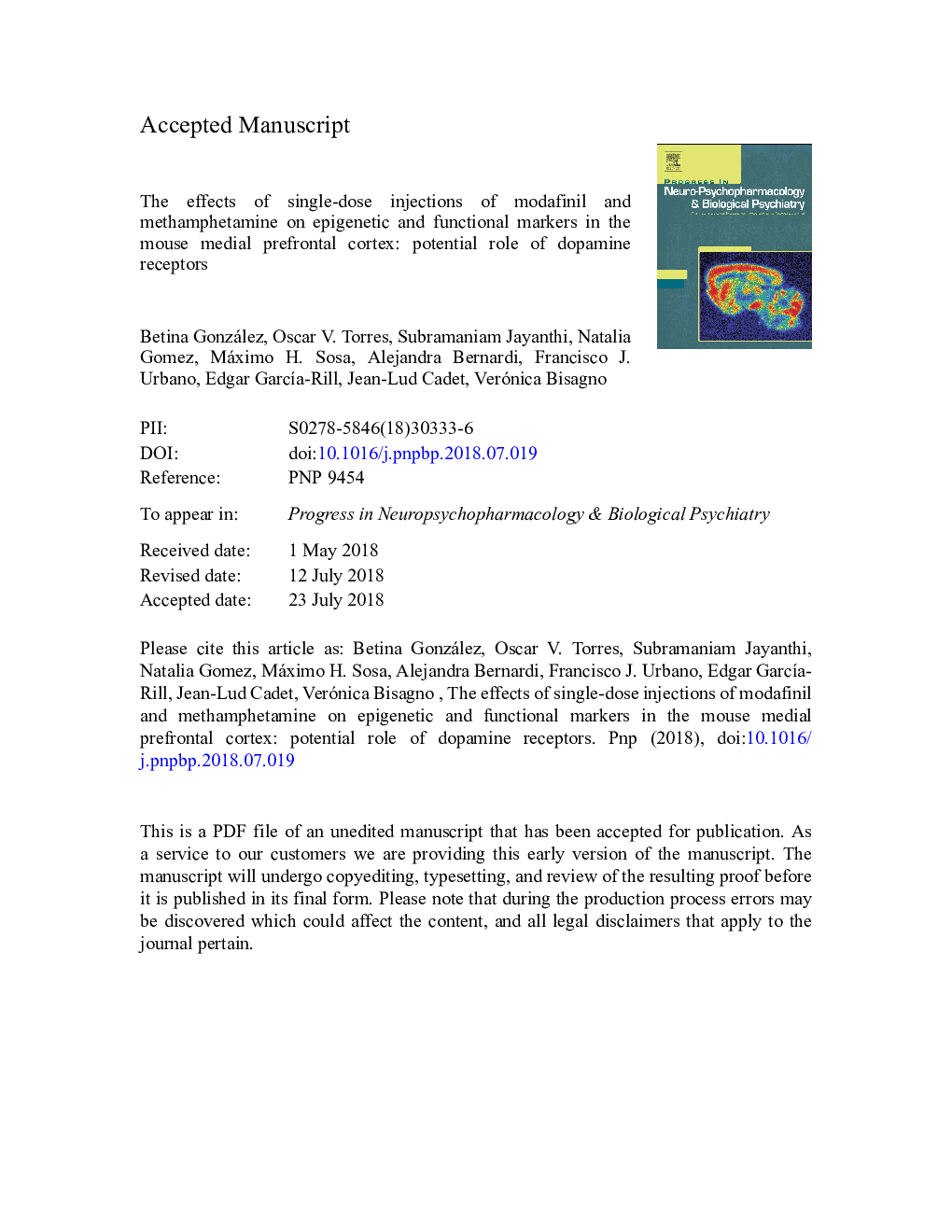| کد مقاله | کد نشریه | سال انتشار | مقاله انگلیسی | نسخه تمام متن |
|---|---|---|---|---|
| 8537157 | 1561006 | 2019 | 34 صفحه PDF | دانلود رایگان |
عنوان انگلیسی مقاله ISI
The effects of single-dose injections of modafinil and methamphetamine on epigenetic and functional markers in the mouse medial prefrontal cortex: potential role of dopamine receptors
ترجمه فارسی عنوان
اثرات تزریق دوزهای دوزهای متافینیل و متامفتامین بر مارکرهای اپی ژنتیک و عملکردی در قشر موش پیش مغز موش صحرایی: نقش بالقوه گیرنده های دوپامین
دانلود مقاله + سفارش ترجمه
دانلود مقاله ISI انگلیسی
رایگان برای ایرانیان
کلمات کلیدی
موضوعات مرتبط
علوم زیستی و بیوفناوری
علم عصب شناسی
روانپزشکی بیولوژیکی
چکیده انگلیسی
METH use causes neuroadaptations that negatively impact the prefrontal cortex (PFC) leading to addiction and associated cognitive decline in animals and humans. In contrast, modafinil enhances cognition by increasing PFC function. Accumulated evidence indicates that psychostimulant drugs, including modafinil and METH, regulate gene expression via epigenetic modifications. In this study, we measured the effects of single-dose injections of modafinil and METH on the protein levels of acetylated histone H3 (H3ac) and H4ac, deacetylases HDAC1 and HDAC2, and of the NMDA subunit GluN1 in the medial PFC (mPFC) of mice euthanized 1â¯h after drug administration. To test if dopamine (DA) receptors (DRs) participate in the biochemical effects of the two drugs, we injected the D1Rs antagonist, SCH23390, or the D2Rs antagonist, raclopride, 30â¯min before administration of METH and modafinil. We evaluated each drug effect on glutamate synaptic transmission in D1R-expressing layer V pyramidal neurons. We also measured the enrichment of H3ac and H4ac at the promoters of several genes including DA, NE, orexin, histamine, and glutamate receptors, and their mRNA expression, since they are responsive to chronic modafinil and METH treatment. Acute modafinil and METH injections caused similar effects on total histone acetylation, increasing H3ac and decreasing H4ac, and they also increased HDAC1, HDAC2 and GluN1 protein levels in the mouse mPFC. In addition, the effects of the drugs were prevented by pre-treatment with D1Rs and D2Rs antagonists. Specifically, the changes in H4ac, HDAC2, and GluN1 were responsive to SCH23390, whereas those of H3ac and GluN1 were responsive to raclopride. Whole-cell patch clamp in transgenic BAC-Drd1a-tdTomato mice showed that METH, but not modafinil, induced paired-pulse facilitation of EPSCs, suggesting reduced presynaptic probability of glutamate release onto layer V pyramidal neurons. Analysis of histone 3/4 enrichment at specific promoters revealed: i) distinct effects of the drugs on histone 3 acetylation, with modafinil increasing H3ac at Drd1 and Adra1b promoters, but METH increasing H3ac at Adra1a; ii) distinct effects on histone 4 acetylation enrichment, with modafinil increasing H4ac at the Drd2 promoter and decreasing it at Hrh1, but METH increasing H4ac at Drd1; iii) comparable effects of both psychostimulants, increasing H3ac at Drd2, Hcrtr1, and Hrh1 promoters, decreasing H3ac at Hrh3, increasing H4ac at Hcrtr1, and decreasing H4ac at Hcrtr2, Hrh3, and Grin1 promoters. Interestingly, only METH altered mRNA levels of genes with altered histone acetylation status, inducing increased expression of Drd1a, Adra1a, Hcrtr1, and Hrh1, and decreasing Grin1. Our study suggests that although acute METH and modafinil can both increase DA neurotransmission in the mPFC, there are similar and contrasting epigenetic and transcriptional consequences that may account for their divergent clinical effects.
ناشر
Database: Elsevier - ScienceDirect (ساینس دایرکت)
Journal: Progress in Neuro-Psychopharmacology and Biological Psychiatry - Volume 88, 10 January 2019, Pages 222-234
Journal: Progress in Neuro-Psychopharmacology and Biological Psychiatry - Volume 88, 10 January 2019, Pages 222-234
نویسندگان
Betina González, Oscar V. Torres, Subramaniam Jayanthi, Natalia Gomez, Máximo H. Sosa, Alejandra Bernardi, Francisco J. Urbano, Edgar GarcÃa-Rill, Jean-Lud Cadet, Verónica Bisagno,
